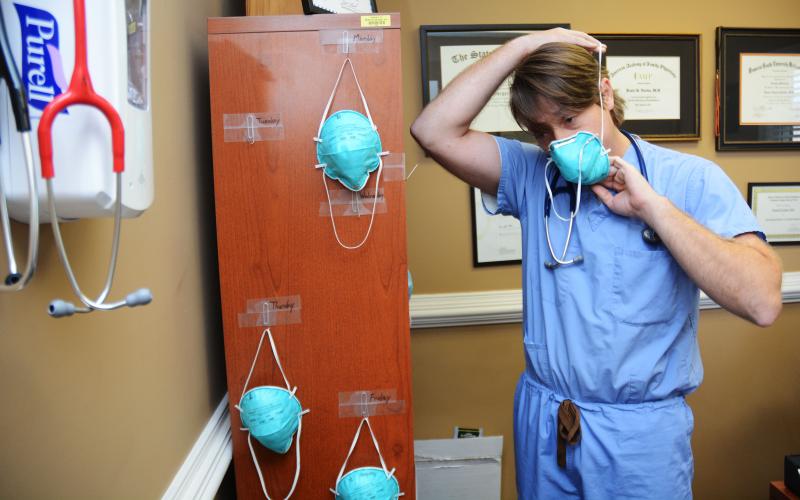Normalcy will eventually creep back into everyday life for most people, but Dr. Daniel Gordon doesn’t expect the medical field will ever be the same. The possibility of COVID-19 as a diagnosis will now always be a possibility.
“This is a tectonic shift,” said Gordon, a doctor at the MedLink clinic in Hartwell. “Think about this, I will now for the rest of my career have a COVID test in my arsenal, and I’ll have to consider that as a diagnosis. Just like we have to look at, is this patient sick enough to have the flu?”
That shift is evident in his profession more than in any other. The term new normal can apply in many different ways, but perhaps it applies most aptly to doctors, nurses and other medical professionals who are having to adjust to a new way of seeing and treating patients.
In February, Gordon didn’t have to set special times for potentially sick patients to come to the clinic. He didn’t have to equip himself, nurses and office staff with facemarks, face shields and other personal protection equipment on a daily basis. Every person who walked through the door didn’t require a temperature check.
Then the calendar turned to March, April, May, and in a matter of weeks, everything had changed for medical professionals, including a heavy new weight of anxiety about the safety not only of patients and staff, but of themselves and their families.
“It has been stressful,” Gordon said.
But as time has gone on, treatments have improved, virus caseloads have begun diminishing and the anxiety has given way to a bit of cautious optimism. At the Hartwell clinic, testing requests have dropped, which is welcomed, Gordon said.
At St. Mary’s Sacred Heart in Lavonia, however, where Gordon also works, he recently has seen a steady stream of patients who are a little younger than they were when the pandemic first emerged, but who still need hospitalization. It’s frustrating to see the same patients come back multiple times as they battle the virus for sometimes more than a month.
“So you strap on your old, reused N-95 mask and pray that it’s not going to get to you,” Gordon said.
The weight of those situations is heavy as medical professionals think about going home to their families, but it is a weight they are honored to carry, Gordon said. Treating patients is why they pursued their careers.
“It really is an honor to be able to take care of sick people, patients with COVID-19,” Gordon said. “It’s an honor and it’s humbling to do it.”
Ruth Tellano-Daniel, a nurse practitioner in the emergency room at St. Mary’s Sacred Heart and a Hartwell resident, said the virus consumed her and her colleagues minds when the virus first broke out in Georgia.
“Literally every five minutes we updated numbers,” she said. “We were concerned and worried.”
That concern is still evident, but after months of fighting the disease and seeing the battle play out around the world, medical professionals have become a little numb to it, she said. Even better, they have become more confident, Tellano-Daniel said.
“We’re getting better and better information from around the world about how to treat patients better,” she said. “That information helps us feel more confident.”
It also adds to the confidence of health care workers when they see people wearing masks, socially distancing and following the guidelines set out by public health officials, Tellano-Daniel said. The more people adhere to the guidelines, the stronger the fight will be.
“It really depends on if people take this seriously and wear masks,” she said. “It depends on us as a society if we are going to do something preventative.”
Like Gordon, she said the weight of being on the frontline of the pandemic has been heavy. She and her husband both are at higher risk than most, so taking the possibility of infection, or infecting others, seriously has been paramount to her family’s safety, Tellano-Daniel said. More and more, she has seen some of the political fervor over the response subside and more and more people following public health guidance.
“I think a lot of people are realizing they need to do it,” she said. Which is good, she added, because, “I don’t want to have to treat them. I don’t want them to be sick.”
Neither medical professional has a crystal ball, but both predict the virus is not going to go away, but treatments will improve and the urgency of the situation will subside.
“I think we’ll always have it, to an extent,” Tellano-Daniel said.
Gordon agrees.
“I think that immunization science will take a quantum leap,” he said. “I do think long term, we will be able to get one or two shots and be considered immune for a while.”
The same thing happened with diseases like polio, chicken pox and measles, Gordon said.
“It is still part of a natural world order, that once we have enough immunity, as it lives in human hosts, it’s going to die down,” he said.
Take the measles, for example.
“Every person who is born in this country gets two measles shots. Still,” Gordon said.
He hopes to see similar measures eventually to fight COVID-19, but this pandemic will stand as a reminder of just how pervasive and dangerous the unchecked spread of disease can be.
“We saw that when we let our guard down, for whatever reason, once you put one strain of virus in a community, it spreads like wildfire.”
Throughout the pandemic, Gordon also noted the creative ways people have found to get back closer to normal life while still doing their part to fight the virus.
“I’m inspired when I see people come together, take it seriously and find new ways to get together,” Gordon said.
Image
Body

